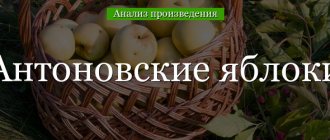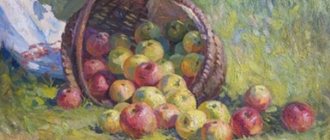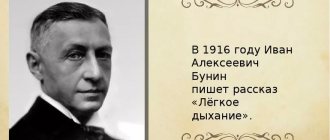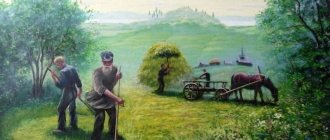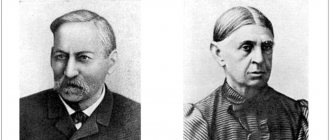Loading…
U. What do you know about the life and work of I. A. Bunin?
D. and U. - Knew the life of the Russian people well. Growing up with peasant children, I heard many songs and stories from the people. He traveled around central Russia, met beggars and holy fools.
— I was fascinated by the soul of a Russian man, a Slav.
— Reflected sadness about Russia’s fading past, whose traditions were created and preserved by the countryside and peasantry for centuries.
— I. A. Bunin’s ideal in the past was the time of the heyday of noble culture, which over time lost the inhuman nature of serfdom. He wrote with regret about the old, departing Russia and looked with fear at the sprouts of the new.
— I saw the possibility of preserving centuries-old traditions in Russia in preserving the village.
— I didn’t believe in happy changes in society.
— I thought that “Russia had gone crazy” in October 1917. The blame for this was placed on the intelligentsia and the people.
— Kept the memory of death: “Every morning think that the coming day is the last day of your life; and every evening - that the coming night is the last night of your life.”
— I. A. Bunin, along with A. P. Chekhov, is considered the greatest master of the short story. The writers had strong friendships.
— He acted as a true artist: through artistic images, without giving his own moral assessments, he posed the most important questions of human existence.
“He treated his works extremely strictly, he agonized over them, corrected them, and often underestimated them at first.
— I looked for inspiration in images of the past, drawing them from religious and literary monuments of antiquity.
— I. A. Bunin was “a painter of the most complex human feelings” (K. I. Chukovsky).
— I tried to dwell on the beauty of reality, its details.
— In his mature period of creativity, he moved further and further away from what he personally saw and experienced and composed more and more often.
— The beginning of the works is extremely compressed, energetic and simplified.
— The artistic speech of I. A. Bunin is an example of a demanding attitude to the word: internal concentration and accuracy of definitions, aversion to panache with a well-spoken word.
— He didn’t just describe natural phenomena, but accompanied them with an emotional assessment that allowed him to grasp the harmonious relationship between nature and man.
— Using the example of the work of I. A. Bunin, it is clear that poetry and prose at the turn of the twentieth century. got closer and closer. On the one hand, he felt music in prose, on the other hand, he introduced narrative, descriptive, natural speech characteristic of prose into poetry.
— In poetry, he was a continuer of Pushkin’s traditions, did not try to introduce anything new into Russian verse and shunned new achievements made by others.
"Antonov apples"
It is possible to listen to an audio recording of the story performed by A. Filozov:
U. - I. A. Bunin conceived the story “Antonov Apples” in 1891, but wrote and published it in 1900 with the subtitle “Pictures from the book “Epitaphs”.
— Remember what an epitaph is and what was the subject of I. A. Bunin’s story with that title, also published in 1900?
D. An epitaph is a gravestone inscription. The story was dedicated to the past of Russia, the impoverishment and desolation of the Russian village.
U. - The story “Antonov Apples” is also imbued with sadness about the fading past of Russia, a tragic feeling of doom of the old world, close and dear to the writer, with whom he was connected by origin and upbringing: “The spirit of this environment, romanticized by my imagination, seemed to me all the more beautiful, that disappeared forever before my eyes.”
- From whose perspective is the story being told?
D. First on behalf of the boy, then on behalf of an adult - a grown boy.
U. What verb constantly sounds in the mouth of the narrator?
D. I remember.
U. Is it possible in this story to highlight the plot, climax, and development of action characteristic of an epic work?
D. It is impossible. The narrator's thoughts, his impressions, his attitude towards them, his experiences are described...
U. — A characteristic feature of I. A. Bunin’s early prose work is the presence of a lyrical plot, in which it is not events that are important, but impressions, a special elegiac mood. I. A. Bunin began his journey in literature as a poet and sometimes did not clearly distinguish between poetic and prose creativity, often used images from his own lyrics in prose, even liked to print poetry and prose under the same cover, emphasizing their inseparability. That is why the story “Antonov Apples” caused bewilderment among critics and contemporaries of I. A. Bunin: “Everything that comes to hand is described.”
— What artistic movement is characterized by the depiction of the world in its mobility and changeability?
D. The property of impressionism.
U. - Despite the fact that I. A. Bunin avoided all deviations from classical art and artistic innovations, elements of impressionism are also inherent in him. And although in the story “Antonov Apples” the epic plot as such is not visible, the story is very subtly and harmoniously organized.
— What is the visible composition of the story?
D. The author divided the story into four chapters. Each chapter is a separate picture of the past:
Part 1 - childhood memories of picking apples;
2nd part - description of the prosperous estate of the aunt - Anna Gerasimovna;
Part 3 - magnificent hunting scenes;
The 4th part is the time of the ruin of the nobility, the end of its former greatness, the life of the small landed nobles.
W. - Reading this story, we trace the whole life of the hero - from childhood to his maturity.
— How are the chapters of the story arranged chronologically?
D. Autumn is consistently described:
Part 1 - “early fine autumn”, Indian summer.
Part 2 - “clear, icy water”, “purple fog”, “turquoise sky” - September.
Part 3 - “gloomy low clouds”, “liquid blue sky”, “icy wind”, “liquid ash clouds” - October.
4th part - “empty plains”, “naked garden”, first snow - November.
U. What chronological uniformity, emphasizing the natural flow of time, is also visible in the composition of each part?
D. Events from morning to evening are described.
U. What are the periods of the hero’s life associated with?
D. With the state of nature:
- Childhood memories of picking apples - with “early fine autumn”, Indian summer.
- Description of the prosperous estate of my aunt - Anna Gerasimovna - invigorating September.
— Hunting scenes with impending October weather.
- The time of ruin, impoverishment - with dank November, deep autumn.
U. What are the objects of observation of the writer?
D. Nature, people, life...
U. What does the author focus on when depicting nature?
D. On colors, smells, sounds.
U. Within what space does the described action take place?
D. Within the boundaries of the landowner's estate, landowner's possessions.
U. - We see the strictest plan, following which, I. A. Bunin wove the lace of his narrative, not allowing himself to miss a single detail, which is why the story turned out to be a picturesque picture, saturated to the limit with visible, sound, olfactory images.
— Following the chronological logic of constructing the story, we will consistently identify the central images of nature, reflected through colors, smells, sounds; images of people; symbolic images; Let's determine the leading mood associated with them at each chronological segment.
A table is provided to help the teacher. Children must consistently give examples so that the compositional harmony of the narrative is revealed as a result of the work.
Loading…
U. What social changes were reflected by I. A. Bunin in the story “Antonov Apples”?
D. The death of the local way of life, the disappearance of entire classes.
U. Summarize your observations and show how this is reflected in the story.
D. The story shows the fate of specific people, and this is perceived as the common fate of the entire noble class, the entire peasantry and all of Russia as a whole. First, the reader is presented with a personal garden that is unusually colorful and magical, like a kind of fairy tale. The image of the house is presented in all its splendor. “Popular, bright, durable” - these are the epithets the lyrical hero gives to the place where he lives. This means that the life of the nobility has not yet been overshadowed by anything. Then the houses of the landowners are depicted as dilapidated and blackened by time, some completely collapsed. The garden became bare and deserted. The epithets “antique, musty, ill-fated, dreary” carry a connotation of decline and decrepitude. There are no more noble nests. The village where the lyrical hero lived became deserted and quiet as never before. There is no more fun in it, no more clucking of birds, no more blooming garden. The verbs used by the author are in the past tense. This is another indication of the passing past.
U. How does the image of the Russian landowner fade in the story?
D. - First, the hero’s aunt is shown - Anna Gerasimovna and her strong life, preserving the traditions of serfdom.
- Then the image of the hero’s uncle is given - the reckless Arseny Semenych, “emerging from the office with an arapnik and a revolver, suddenly deafening the audience with a shot” and laughing. “He is tall, thin, but broad-shouldered and slender, and has a handsome gypsy face. His eyes sparkle wildly, he is very dexterous, wearing a crimson silk shirt, velvet trousers and long boots.” Arseny Semenovich recites poems by A. A. Fet about hound hunting. But the guy’s life ended tragically - he shot himself.
- Finally, a small-scale nobleman is depicted, his “sleepy face of the Tatar warehouse”, common clothes, household chores, lack of funds. As a result, an inexpressive picture is given: the master is depicted with his trunk covered, “all gray from it.”
U. - “Bunin is one of the varieties of the “repentant nobleman.” Only his repentance is very peculiar... It is this feeling of general guilt, this participation in sin, this lack of indifference and extraneous curiosity - this is precisely what explains why Bunin’s pages do not make an offensive impression and do not outrage against the author” (Yu. I. Aikhenvald).
- “Bunin, like few people before him in our literature, knows the life, needs, everyday calculations and dreams of the small landed gentleman, often already on the verge of real poverty, and the “starving peasant,” and the growing fat, gaining strength of the rural trader , and a priest with a clergyman, and a tradesman, a buyer or tenant, wandering around the villages in hopes of “turnover,” and a poor teacher, and village authorities, mowers. He shows life, housing, food and clothing, habits and habits of all this motley people in a visual way that is sometimes close to naturalism, but like a true artist he always knows the limit, the limit...” (A. T. Tvardovsky).
— How does the mood of the lyrical hero change depending on changes in the way of life?
D. In the first part everything is calm and serene. The era of the nobility is still in its prime; there is not a single hint that its decline will soon occur. The lyrical hero rejoices at everything that surrounds him at this moment. The main character, a boy, grows up, and the era of nobility gradually declines. The spirit of decline and ruin of the nobility extinguishes the joy of the people living at that time. The third chapter is a turning point in the story. The era of nobility has not yet passed, but is gradually ending. The lyrical hero feels broken and depressed, he is filled with a feeling of emptiness, melancholy and loneliness. The narrator experiences pain and reverently relives his memories.
U. - I. A. Bunin was called “a chick who flew out of a noble nest, who sang a requiem for estate life.” He said: “The sadness of space, time, form has haunted me all my life...” The author’s contemporaries more than once noted the special philosophical meaning in his works.
— How did the author manage to combine the image of the hero’s inner world with a description of nature: images, colors, sounds, smells?
D. - In the first part, the sky is clear and azure, gold, red, white, azure colors, and “diamond” shine predominate. All the colors chosen by the author to describe the garden are very warm and sunny. Everything is filled with joy, happiness, a sense of celebration, love, and faith in the best. But from chapter to chapter the colors fade, the colors become darker: purple, dirty yellow, blue. The sky is now overcast with clouds through which no sunlight can penetrate; it itself is “liquid blue” and constantly “sows rain.” Gradually, black becomes the predominant color - the color of mourning and grief. Everything turned black around: the garden, the foliage, the house and the sky. The description of dampness and cold, the range of dark colors indicate to us the withering and decline of the nobility. The bright world of childhood disappeared along with the sun, and was replaced by a gray and boring present.
— The measured sounds of the voices of house-smart townsfolk, the clucking of blackbirds, the knocking of apples being poured, the creaking of gates fade away in the second part. The loud and sharp cries of roosters and geese can be heard. In the third part, the sounds of dogs yapping, barking, and screaming become harsh, endless, annoying, shrill and discordant. “Home” sounds can no longer be heard. In the fourth part, “the wind rings and hums in the barrel of a gun.”
— The first part of the story conveys the aromas of fallen leaves, apples, honey, kulesh, and the “fragrant” smoke of cherry branches. In the second part it is noted that the smell of Antonov apples can be “heard” in the house. In the third part, the smells disappear. But in the fourth, the smell of home and housing is mentioned as a glimmer of hope.
U. — Happiness for I. A. Bunin is a complete merger with nature. Happiness is available only to those who have penetrated its secrets. He considered himself one of the lucky ones. The author’s skill lies in the fact that thanks to these subtle images, a complete picture emerges in our minds. In our imagination we see, hear, smell the life of a noble estate, a village, plunging together with the author into the atmosphere that the hero talks about, we are imbued with his feelings of light sadness, the bitterness of loss and at the same time a sense of hope.
“By poeticizing the facts, (Bunin) is not afraid of the old, but not aging values of the world, he does not hesitate to sing what many eyes have already stopped on, what many other people’s lips have already sung.” “The poet is restrained, he does not impose his mental states on nature, he loves her for herself: after all, it is not at all necessary that she necessarily and always correspond to something human. Bunin does not want to say more than is true: he, the truthful one, has words that correspond to the phenomena, and that is why you believe him, you don’t doubt him. Careful and chaste, a classic of life, he does not invent, does not compose, and does not introduce himself into places where one can do without him. When he speaks about himself, it is an internal necessity, and the word rightfully belongs to him” (Yu. I. Aikhenvald).
— Can you see how the image of Antonov’s apples permeates the entire story and concentrates its meaning?
D. 1st chapter - aroma, crunch, booming sound of apples.
Chapter 2 - “vigorous Antonovka”, an abundance of apples, comfort in the house from their smell.
Chapter 3 - a “forgotten cold and wet apple” found in the foliage, which seems unusually tasty.
Chapter 4 - disappearance of the smell of apples.
U. - “In addition to the smells that densely fill all his works, inherent in the seasons, the village cycle of field and other work, smells familiar to us from the descriptions of others - melted snow, spring water, flowers, grass, foliage, arable land, hay, grain , vegetable gardens and the like - Bunin hears and remembers many more smells characteristic, so to speak, of historical time, era.” “This side of Bunin’s expressiveness, which gives everything the writer talks about a special naturalness and noticeability...” (A. T. Tvardovsky).
— Conclude what the Antonov apples symbolize in I. A. Bunin’s story?
D. Antonov apples are a symbol of childhood, prosperity, the stable age-old way of life of peasants and landowners, a symbol of Russia, a symbol of life in general.
U. “Bunin is not just a master of unusually accurate and subtle captures of nature. He is a great expert on the “mechanism” of human memory, at any time of the year and at any age, powerfully evoking in our soul hours and moments that have sunk into oblivion” (A. T. Tvardovsky).
— I. A. Bunin’s work is characterized by thoughtfulness and refinement of presentation, strict beauty of verbal coinage, and a consistent style, submissive to the subtle curves and shades of the author’s intention. I. A. Bunin's stories are full of folk wisdom. How is this expressed?
D. The author uses proverbs and sayings, folk signs:
- ... “autumn and winter live well if the water is calm and there is rain on Laurentia.”
“Then, in the Indian summer, a lot of cobwebs fell on the fields. This is also a good sign: “There is a lot of networking in the Indian summer - the autumn is vigorous.”
- “Vigorous Antonovka - for a fun year.”
U. — The ending of the story is symbolic. How does it resonate with the beginning?
D. At the beginning - the cool silence of the morning, at the end - late evening, when “the outbuilding windows glow in the darkness of the winter night.” This is the symbolic dawn and twilight of noble life.
U. What significant punctuation mark is used at the beginning and end of the story?
D. Ellipsis. At the beginning it gives the character of memories, at the end - the meaning of understatement and sadness for the past noble life, for the disappeared youth.
U.I.A. Bunin “struggles with the finitude of the moment... Struggling with oblivion, passionately trusting in Memory. He fights death as a sacrament in which the heart refuses to believe” (O. V. Slivitskaya).
Preview:
Literature lesson 11th grade.
“Paradise Lost” by I.A. Bunin using the example of a story
1). Identify students’ first impressions of the work they read;
2). Follow how the hero’s age changes and, along with it, the perception of the world;
3). Draw students' attention to the intonation of light sadness in the story;
4). To conclude that this story widely includes landscapes that help to most deeply understand the internal state of the hero and express nostalgia for the bygone past;
5). Consider the image of nature, the image of the human world, the mood of the hero-storyteller, the images and symbols of the story “Antonov Apples”.
1). To develop students’ skills in literary critical analysis of a work;
2).to develop in students the skill of complete, competent oral response;
3). Develop the ability to draw conclusions and generalizations.
1). Instill in students a sense of beauty;
2). Raising a cultural reader;
writing; interest in the history of language and people
Chapter 3
From it we learn about the writer's passion for hunting. After all, it was a popular entertainment for the landowners of those years. Hunting wolves made it possible to reduce the number of this dangerous predator, which killed livestock and could attack humans. In the company of fellow hunting enthusiasts, the author shot wolves or other animals and returned home with the trophies to his aunt or stayed for several days with a landowner he knew.
Summary
“Antonov Apples” is the personification of nostalgia, antiquity, and childhood. The meaning of the title of the work is also hidden in the symbolic meaning. The story is a series of descriptions of the life of the nobles, which are united by the memories of the main lyrical character (the narrator). At first, for some reason, he imagined a golden garden, the onset of autumn, and the apple harvest.
All this was managed by the owners who lived in a hut among the trees; on holidays they organized a huge fair. The garden was crowded with peasants, they simply amazed with their contentment: children, boys and girls - everyone treated each other and the nobles well. The idyll of the picture is complemented by natural landscapes; at the end of this part the main character says: “How dewy, cool and how good it is to live in the world!”
A fruitful year on the family estate of the narrator Vyselka is simply pleasing to the eye: there is contentment in everything, everywhere there are joyful faces and the prosperity of ordinary men. The main character himself would like to be a peasant, not seeing any problems in this fate, but only good health and natural unity with nature, and absolutely not humiliation, lack of land and poverty.
From the life of peasants, he moves on to the nobles of the previous era of serfdom , when landowners were still assigned the main role in society. An example is the estate of Aunt Anna Gerasimovna, in which one could feel the severity, wealth, and loyalty of the peasants. The description of the house also seems to be frozen in the past, even everyone is talking only about the past, but poetry can also be traced in this.
Hunting, one of the popular activities of landowners, is discussed separately. Arseny Semenovich, who was the narrator's brother-in-law, organized large-scale forays, often lasting several days.
The whole house was crowded with people, dogs, cigarette smoke, and mash. The memories and conversations about this event are remarkable.
The main character saw this fun even in a dream, when he was dozing on feather beds in some remote bedroom under icons. But it’s also nice to miss the hunt, because in the old estate there are magazines, paintings, and books everywhere, looking at which evokes a “strange and sweet melancholy.”
However, changes took place in life, existence became “small-scale” and “beggarly.” But it still contains remnants of past greatness, poetic echoes of past noble happiness.
Composition and genre
The genre of the work is epitaph, since the story does not have a traditional plot line. In fact, the text contains only a fragmentary description of the narrator's memories.
All moments are united by the personality of the lyrical hero and his emotional mood. There is no plot dynamics in the work. The plot consists of the accumulation of different memories, the main element for their appearance is the aroma of apples.
The story has 4 parts:
The story was divided into four parts for a reason - this is how the writer showed the life cycle and the onset of adulthood instead of youth.
Brief Analysis
Year of writing – 1900.
History of creation - In 1891, I. Bunin stayed at the estate of his brother Evgeniy. Once, going outside, the writer caught the smell of Antonov apples, which reminded him of the times of the landowners. The story itself was written only 9 years later.
Theme - Two themes can be distinguished in the story: autumn in the village, the free life of landowners, filled with the romance of the countryside.
Composition - The organization of the story is special, since the outline of the events is very poorly represented in it. The main role is played by memories, impressions, and philosophical reflections, the basis for which are landscapes.
